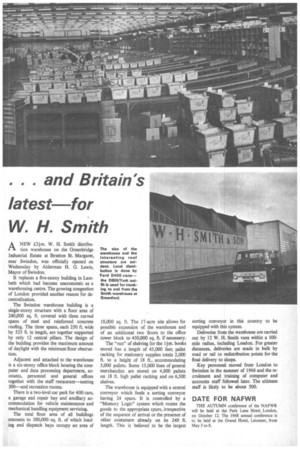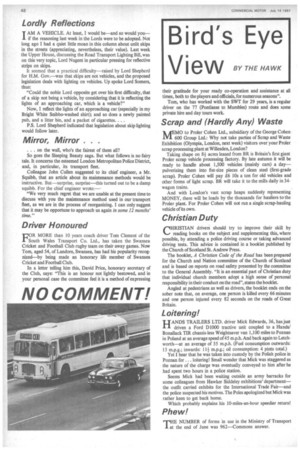latest for W. H. Smith
Page 49

Page 50

If you've noticed an error in this article please click here to report it so we can fix it.
NEW £3im. W. H. Smith distribu tion warehouse on the Greenbridge Industrial Estate at Stratton St. Margaret, near Swindon, was officially opened on Wednesday by Alderman H. G. Lewis, Mayor of Swindon.
It replaces a five-storey building in Lambeth which had become uneconomic as a warehousing centre. The growing congestion of London provided another reason for decentralization.
The Swindon warehouse building is a single-storey structure with a floor area of 240,000 sq. ft. covered with three curved spans of steel and reinforced concrete roofing. The three spans, each 250 ft. wide by 525 ft. in length, are together supported by only 12 central pillars. The design of the building provides the maximum amount of daylight with the minimum floor obstruction.
Adjacent and attached to the warehouse is a six-storey office block housing the computer and data processing department, accounts, personnel and general offices together with the staff restaurant—seating 300—and recreation rooms.
There is a two-level car park for 400 cars, a garage and repair bay and ancillary accommodation for vehicle maintenance and mechanical handling equipment servicing.
The total floor area of all buildings amounts to 380,000/ sq. ft. of which loading and dispatch bays occupy an area of 18,000 sq. ft. The 17-acre site allows for possible expansion of the warehouse and of an additional two floors to the office tower block to 450,000 sq. ft. if necessary.
The "run" of shelving for the 1-1-m. books stored has a length of 45,000 feet; pallet racking for stationery supplies totals 2,000 ft. to a height of 18 ft., accommodating 5,000 pallets. Some 15,000 lines of general rnerchandize are stored on 4,800 pallets on 18 ft. high pallet racking and on 6,500 shelves.
The warehouse is equipped with a central conveyor which feeds a sorting conveyor having 24 spurs. It is controlled by a "Memory Logic" system which routes the goods to the appropriate spurs, irrespective of the sequence of arrival or the presence of other containers already on its 240 ft. length. This is believed to be the largest sorting conveyor in this country to be equipped with this system.
Deliveries from the warehouse are carried out by 12 W. H. Smith vans within a 100mile radius, including London. For greater distances, deliveries are made in bulk by road or rail to redistribution points for the final delivery to shops.
Key personnel moved from London to Swindon in the summer of 1966 and the recruitment and training of computer and accounts staff followed later. The ultimate staff is likely to be about 500.
DATE FOR NAFWR
THE AUTUMN conference of the NAFWR will be held at the Park Lane Hotel, London, on October 12. The 1968 annual conference is to be held at the Grand Hotel, Leicester, from May 5 to 8.
Lordly Reflections
T AM A VEHICLE. At least, I would be—and so would you— if the reasoning last week in the Lords were to be adopted. Not long ago I had a quiet little moan in this column about unlit skips in the streets (appreciating, nevertheless, their value). Last week the Upper House, discussing the Road Transport Lighting Bill, was on this very topic, Lord Nugent in particular pressing for reflective strips on skips.
It seemed that a practical difficulty—raised by Lord Shepherd for H.M. Gov.—was that skips are not vehicles, and the proposed legislation deals with lighting on vehicles. Up spoke Lord Somers, thus: "Could the noble Lord opposite get over his first difficulty, that of a skip not being a vehicle, by considering that it is reflecting the lights of an approaching car, which is a vehicle?"
Now, I reflect the lights of an approaching car (especially in my Bright White Snibbo-washed shirt); and so does a newly painted pub, and a litter bin, and a packet of cigarettes. . . .
P.S. Lord Shepherd indicated that legislation about skip lighting would follow later.
Mirror, Mirror . . •
... on the wall, who's the fairest of them all?
So goes the Sleeping Beauty saga. But what follows is no fairy tale. It concerns the esteemed London Metropolitan Police District, and, in particular, its transport fleet.
Colleague John Cullen suggested to its chief engineer, a Mr. Squibb, that an article about its maintenance methods would be instructive. But—surprise, surprise—this turned out to be a damp squibb. For the chief engineer wrote:— "We very much regret that we are unable at the present time to discuss with you the maintenance method used in our transport fleet, as we are in the process of reorganizing. I can only suggest that it may be opportune to approach us again in some 12 months' time."
Driver Honoured
VOR MORE than 10 years coach driver Tom Clement of the South Wales Transport Co. Ltd., has taken the Swansea Cricket and Football Club rugby team on their away games. Now Tom, aged 54, of Landore, Swansea, has had his popularity recognized—by being made an honorary life member of Swansea Cricket and Football Club.
In a letter telling him this, David Price, honorary secretary of the Club, says: "This is an honour not lightly bestowed, and in your personal case the committee feel it is a method of expressing


























































































































